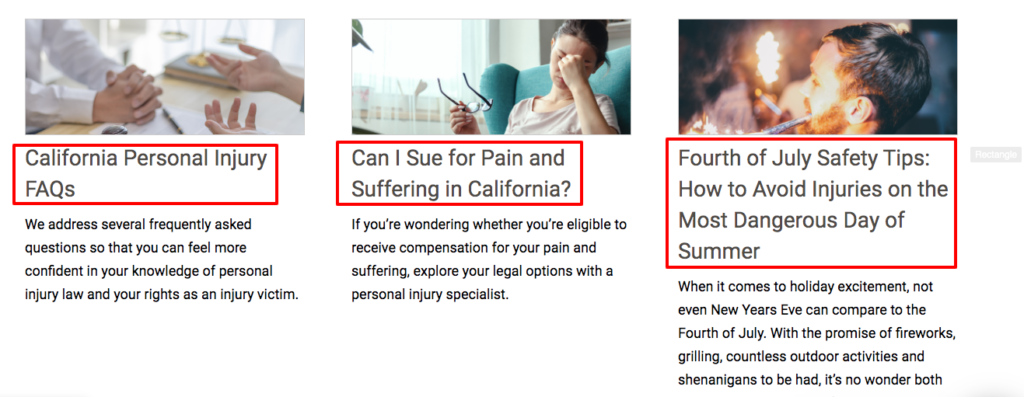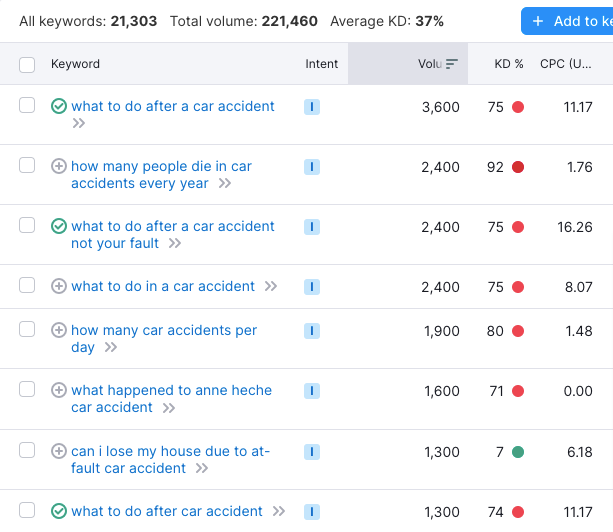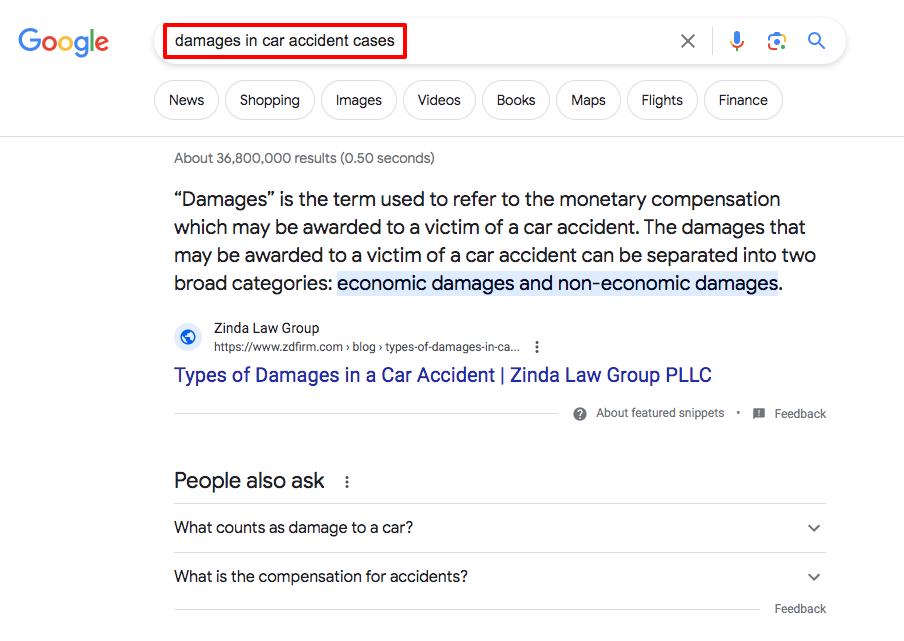Personal Injury Law Website Content Writing
In SEO, it all comes back to content. And it always will.
Otherwise, what would the search engines rank, exactly? What would they serve up to their users?
It’s all about content — and that’s why personal injury law website content writing is such a big deal.
Content writing is essential to SEO for personal injury firms, plain and simple. Now, let’s talk about how to do it the right way.
Types of Content for Personal Injury Law Firm Sites
There are dozens of types of content, but for personal injury law firm websites, two main types of content matter MUCH more than any others:
- Blog posts
- Practice area pages
Let’s take a closer look at each type.
Blog Posts
Blog posts for personal injury websites usually target common personal injury-related questions or concerns that the firm’s ideal clients might have.

Here are some example personal injury blog post titles:
- Who Is at Fault for My Car Accident?
- Who Pays My Medical Bills After a Slip-and-Fall
- Understanding California Dog Bite Laws
As you can see, the aim is to answer your potential clients’ questions about their cases.
And the idea, from an SEO perspective, is that they type those questions into Google, your blog post “ranks” for the query, the client clicks on your result, and, eventually, they contact you for legal help.
Practice Area Pages
Some people call them landing pages, but attorneys call them practice area pages. That’s because these pages showcase your practice areas.
One of those practice areas will be personal injury, of course. But you shouldn’t stop there. You’ll want to cover all kinds of “sub-practice areas” — which really focus on case types:
- Car Accident
- Motorcycle Accident
- Truck Accident
- Slip-and-Fall Accident
- Dog Bite
- Wrongful Death
- Work Injury
- Etc.
Usually, you add the city you’re serving on the front end of those phrases. And the word “lawyer” or “attorney” on the back end.
Like this:

- NYC Car Accident Lawyer
- Chicago Motorcycle Accident Attorney
- Houston Truck Accident Lawyer
- Austin Slip-and-Fall Accident Attorney
- Miami Dog Bite Lawyer
- Seattle Wrongful Death Attorney
- Philadelphia Work Injury Lawyer
- Etc.
Those are the titles of practice area pages. But what do you write under them?
Basically, you discuss the case type and showcase your services. You sell your firm. And you convince readers to take action.
While you want to create blog posts on an ongoing basis, you’ll only need to create one practice area page for each practice area.
And if you’re doing them right, they’ll start bringing in cases pretty quickly.
How to Write Personal Injury Law Website Content: 13 Steps
Make no mistake:
Personal injury law website content writing is an art. Some people devote their entire careers to it.
Hint: They’re usually not attorneys. Because few attorneys have the time to devote to doing this right. But also because you need an understanding of personal injury CLIENTS more than you need an understanding of personal injury LAWS.
Does that mean that you, a personal injury attorney, CAN’T write your own content? Of course not.
But you’ll need to make sure you’re getting the basics right. And that’s exactly what I’ve compiled below.
Follow these legal 13 content writing rules to the letter, and your content will be well on its way to dominating the Google rankings:
1. Start with Keywords
You can’t just write blind. You need to KNOW that someone is actually searching for the personal injury topics you’re writing about.
How do you know that? By studying keywords.
Keywords are, technically, anything people enter into search engines like Google. But in the sense we’re discussing them, they’re words and phrases that appear in common SEO tools, alongside various data points that tell you whether they’re worth targeting.
SEO tools like Semrush, Ahrefs, Moz, and others compile data about the ways people use search engines. And they use that data to generate keyword data you can use to guide your personal injury law content writing.
For example, here’s a look at Semrush’s Keyword Magic Tool:

I used the seed keyword (a basic, broad phrase used to generate keyword ideas inside SEO tools) “car accident” to generate that list.
And in the various columns, I can see a few data points of interest:
- Search volume. An estimate of the number of times the keyword is searched on Google each month. More search volume means more web traffic potential but, usually, more competition.
- Search intent. Refers to what the search engine user is expecting to find when searching the keyword. There are four main types of search intent: informational, navigational, commercial, and transactional.
- Keyword difficulty. A metric that approximates how difficult it will likely be to rank on the first page of Google for the keyword. It’s on a scale of 0 to 100, with 100 being the most difficult.
Examine these metrics as you do your keyword research. Make a list of the keywords that are relevant to your personal injury firm, have at least some search volume, match the right intent to serve to your ideal clients, and have a somewhat attainable keyword difficulty level.
2. Optimize It
What do you do with those keywords once you’ve found them? You optimize your content with them.
Start with the title. Let’s say one of your keywords was “do I have to go to court for a car accident?”
That’s your blog post title right there.
Then, make sure the keyword appears in the following places in the content:
- The title tag
- The meta description
- The introduction
- An H2 or H3 (subheader types)
- The conclusion
Bonus points if you can include the keyword in the alt text of a relevant image, the anchor text of at least one link on the page, and the URL of the page.
Why does this matter?
Because it’s how search engines understand that the page is about the given keyword.
Search engine bots are just computer programs. They’re looking for a defined set of signals that will tell them what internet content is about.
By properly optimizing your personal injury law firm’s web content, you’re giving search engines those signals. And that’s what they need in order to rank your website for keywords that will bring you new cases.
3. Nail the Search Intent
We briefly touched on search intent earlier. It’s all about what the search engine user expects to find when they search a keyword.
Someone searching “Austin car accident attorney” is looking for an attorney who handles car accident cases in Austin, Texas.
Someone searching for “California dog bite laws” is looking for a breakdown of the various laws relating to dog bites in California.
Seems simple, but SO many law firms miss search intent in their content. And that’s a fatal mistake where Google is concerned.
Because Google does NOT want to serve the wrong type of content to its users. So it won’t rank you if you miss the search intent.
So, for any content you’re creating, ask yourself what the searcher of the keyword you’re targeting actually WANTS to see.
Then, give them exactly that.
4. Write for Clients, Not Attorneys
As an attorney, you can probably write circles around 99 percent of the population.
But can you write for a general internet audience? If you want your personal injury content to succeed, you’re going to have to.
SO many attorneys, for one reason or another, write website content as if they’re writing a legal document. And a legal blog post and a legal document could not be more different.
When your potential clients see that kind of legalese on their computer screens, they’ll either bounce to another website that answers their question in a way they can understand or fall asleep right then and there.
You don’t want either thing to happen. That’s why you need to create content that’s in plain, everyday English that non-lawyers can understand.
I know it’s painful, but this is important. And it works.
Ask yourself: Did I know what this word meant before I went to law school? If the answer is no, leave it out of your website content.
Also, use tools like the Hemingway Editor to make sure your content’s readability level is at an eighth grade level or lower.
And, to clarify, that means writing so an eighth grader can understand — NOT writing like an eighth grader.
5. Follow the SERP
In SEO content writing, the search engine results page (SERP) is super important. In case it’s not clear, the SERP is the page of Google results for the keyword you’re hoping your content will rank for.
Let’s say you’re creating content that you hope will rank for the keyword “damages in car accident cases.” Here’s the SERP for that keyword:

What are you supposed to do with that, exactly? Read every result. And take a look at the features on the SERP.
In the example above, we have a featured snippet at the top and a People Also Ask box immediately below that.
That tells you that there’s a chance to capture that featured snippet with a similar definition to what’s already appearing there. And that you should probably include an FAQ section in your content to try and appear in that People Also Ask box.
Take a look at the other regular results on the SERP, too. Specifically, make note of their content formatting and what they cover.
This is the stuff Google thinks is most relevant to the keyword. That’s why it’s on page one of the Google results.
And that means you need to cover the same stuff — while also approving on it — and in the same basic format.
6. Cut the Fluff
Online readers are in a hurry. They have no time for fluff.
So, don’t include it ANYWHERE in your personal injury law website content writing.
I’m dead serious. Cut all unnecessary words from your content. And keep your sentences short and direct.
Do this religiously, and you’ll see that people engage more with your content. They get their answers faster, they scroll more, they have an all-around better experience reading YOUR stuff on YOUR website.
That sends all kinds of positive signals to Google, and it’s great for conversion — i.e, getting readers to contact your law firm.
7. Link to Helpful Resources
Attorneys are the experts when they write their own content. They don’t really NEED sources.
But you should still link to sources.
Why? Because Google wants to see that. And it’s a positive signal that you intend to actually provide a helpful resource for your readers.
It doesn’t have to be anything crazy. Just link out to the relevant statute when you mention a law. Or when you mention a particular government agency, link to its website.
Just make sure you ONLY link to reputable, high-quality, official sources. Try to link to .govs, .edus, and .orgs and NOT .coms, .nets, and the like except in rare cases.
8. Make a Publishing Schedule
Content writing for personal injury websites is not a one-and-done endeavor. You have to be consistent.
But who has the time for that? Most injury lawyers certainly don’t.
That’s why you need to make a publishing schedule.
This can be as simple or as complex as you want it to be. But the main point is that it gets you consistently publishing search engine-optimized blog posts on your firm’s website.
If you can only handle one blog per month, that’s fine (although more aggressive publishing tends to achieve faster results). Just put it on your calendar. And stick to it.
If you don’t, you’ll see your SEO results slow or even fall off over time. Google is a beast that needs to be fed, and it eats content.
9. Use Header Tags
Online content meant to rank in search engines needs to include header tags. In SEO, we like to call them H-tags.
These are HTML attributes you wrap around headings and subheadings.
At the start of this tip, the text “Use Header Tags” is a header tag itself. It’s an H3.
Each piece of content should only have one H1 — this functions as the title of the page. Sections of the content should have H2s. And any subsections should be H3s.
You can go all the way down to H6, but you probably won’t need to.
Why does this matter? Because search engines confer extra importance onto the text that appears in H-tags.
That also means that you should try to use the keywords you’re targeting in H-tags, too. This is a quick and simple way to help Google understand your content and know what to rank it for.
10. Emphasize E-E-A-T
E-E-A-T stands for experience, expertise, authoritativeness, and trustworthiness. It’s a super important consideration in SEO content.
I won’t bore you with all the technical details, but it basically is a concept Google uses to evaluate whether content is credible (and therefore should rank well in search results).
It’s particularly important for subjects that can have severe effects on people’s lives. Like law.
The good news is that licensed attorneys have E-E-A-T in spades. You just have to make sure that’s clear in your content.
That means using your name as the author of your blog posts, linking to a detailed “About” page with your credentials and achievements clearly outlined, and even mentioning your own experience with particular subjects you’re writing about.
That’s all going to show Google — actually, humans who work for Google (it’s complicated) — that your content is credible and therefore worthy of No. 1 rankings for important personal injury keywords.
11. Be the Best Result
Google wants to serve the absolute best content to its users. That means the content that best answers the query.
So, if you want to rank No. 1 for your highly competitive personal injury keywords, you need your personal injury content to be the absolute best result Google has to choose from.
Now, it’s not a perfect system. Googlebot is just a computer program, after all. But over time, Google, like other search engines, has worked to perfect its algorithm — so that it always serves the best possible content to answer each query.
So, if you’re consistently creating content that’s the best there is, your results are going to be good and consistently get better over time, as Google improves.
How, exactly, you know what will make your content the “best” is somewhat subjective. But it involves reading what’s already out there and looking for weak spots. Improve upon those weak spots in your content.
12. Provide Value Before Promotion
As a personal injury attorney, you’re running a business. So it’s understandable that you’ll want to promote your services in your personal injury law content.
I get it. But take a deep breath first. And commit to providing value to readers first and foremost.
Here’s the thing:
Your readers are not going to learn everything they need to know to successfully represent themselves in their injury claims. And if they do, the claim was probably not worth your time, anyway.
So, you’re not “giving too much away” or anything like that. And readers are sophisticated enough to understand that you can help them with their lawsuits because you’re a personal injury attorney and you’re writing the authoritative content they’re reading.
Believe that, and then create content that provides value BEFORE promoting your services.
You can absolutely promote your services at the end. In fact, you should, and your website should also be quite promotional in general.
But answer the search query you’re hoping to rank for first. Be helpful. That’s what Google wants to see, and it’s what actually convinces readers that you can do the legal job they need done.
13. Tell Readers What to Do Next
When you do get around to promoting your services at the end, don’t just say you can help readers recover compensation for their injuries and leave it at that.
I believe readers are simultaneously smarter and dumber than publishers give them credit for.
They’re smart enough to smoke you out if you’re faking credibility, but they’re dumb enough to get totally lost if you don’t tell them what to do after they consume your content.
So, in your blog post and practice area page conclusions, be very clear about what the reader should do next.
In almost every case, it’s going to be some version of the following:
- Call (222) 555-0000 to schedule a free consultation.
- Reach a trusted personal injury lawyer by filling out the contact form below.
- Send us a text to learn more about how we can help you recover compensation.
And so on (you can steal those if you want).
Just make sure you’re extremely clear about what your readers are supposed to do.
Write Winning Content for Your Personal Injury Website
With the tips above, you have everything you need to master personal injury law website content writing.
It’s going to take practice — trial and error and everything like that. But these are proven tips that I’ve personally seen work for hundreds of law firms.
And, of course, if you need help creating incredible content, give us a shout.